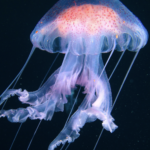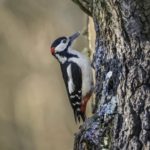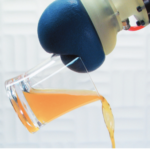Currently there are many designs that are modeled after marine animals. For example, wind turbines are modeled after the fins of whales when they swim. Little is known about the jellyfish’s movement, however. This paper explores the science behind the swimming mechanism of a jellyfish. The researchers […]
UC Berkeley featured biomimicry
Researchers observed the Woodpecker’s exceptional ability to absorb shock. For reference, they withstand 1200gs of force whereas a human receives 120gs of force in a car crash. In an observation of the Woodpecker’s structure, researchers hoped to biomimic the Woodpecker’s ability to create better shock absorption structures. The researchers concluded that […]
Taking inspiration from squid skin, researchers have invented an adaptive composite material that can insulate beverage cups, restaurant to-go bags, parcel boxes, and even shipping containers.
Learn more (opens external site)
Investigating the complex and highly ordered mineralized skeletal system of the knobby starfish, a team of U.S. National Science Foundation discovered an unexpected combination of characteristics that may lead to developing an entirely new class of high-performance lightweight ceramic composites.
The team examined ossicles, calcareous skeletal […]
With more research on hummingbird flight precision and its everyday implications, having drones that can effectively examine natural uncharted territories might happen sooner than previously believed. These drone advancements can be applied to weather monitoring, parcel shipping and even cinematography.
Learn more (opens external site)
When we think of robots, we immediately envision them being made out of hard and durable metal. However, soft materials within animals have inspired a new wave of “soft robots”. This paper discusses the recent development in “Soft Robotics” and explains the mechanisms […]
This bio-inspired glue can seal wounds in just 15 seconds
Researchers and engineers have designed an innovation biocompatible enough to seal wounds and stop bleeding. This innovation is inspired by the “sticky stuff” barnacles use to cling to rocks and can form a tight seal quickly in challenging environments and/or surfaces. With this innovation, there could be casting improvements in traumatic wound care and save […]
Human-Centered Design, Design Innovation, DESINV 98, UC Berkeley
The Human-Centered Design DeCal is an intro to design theory and practice, focusing on human-centered design and digital interfaces. The class meets weekly to have discussions, invite guest speakers, engage in activities that develop fundamental design skills, work towards a semester-long user research/design project. The course is offered every semester, this […]
Organization: The Alt: Meat Lab, Berkeley
The Alt:Meat Lab is housed at the Sutardja Center for Entrepreneurship & Technology at UC Berkeley’s College of Engineering, and is comprised of the Lab and a project driven class offered to undergraduate and graduate students. It aims to connect students, entrepreneurs, venture capitalists and industry leaders […]
Learn about our two Decals!
 Click here to find out more about our Fall Bioinspired Design Decal and our Spring Bioinspired Design in Action Decal – ALL MAJORS are welcome.
Click here to find out more about our Fall Bioinspired Design Decal and our Spring Bioinspired Design in Action Decal – ALL MAJORS are welcome.Berkeley BioDesign Community
 Click here to learn about the BioD: Bio-Inspired Design @ Berkeley student organization or here to signup for more info.
Click here to learn about the BioD: Bio-Inspired Design @ Berkeley student organization or here to signup for more info.Search
Student Login










I imagine that the neurological circuits underlying these processes are governed by both 2d spacing maps with their brains as…
to reduce the impact of car accidents, it may be possible to study the force diverting physics of cockroaches to…
you see this type of head-bobbing stability in many avian creatures related to pigeons like chickens. the head ability to…
not like they taught horses how to run! this is an example of convergent evolution where both sea creatures and…
The brain functions in a similar way with neuronal connections. our brains are able to utilize the multiplicity of connections…